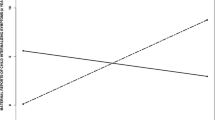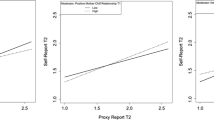Abstract
In a prospective population-based study, mothers and fathers of 1,247 children reported their physical and mental health during pregnancy, after delivery, within the child’s first 18 months of life, and at 12 years. Additionally, maternal health clinic nurses rated parents’ well-being and perceived need for support. At age 12, child outcomes were also measured using CBCL and YSR externalizing and internalizing scales. Results indicate that both ante- and postnatal maternal distress predicted future externalizing problems in offspring. Conversely, fathers’ postnatal distress predicted subsequent internalizing problems. Furthermore, mother’s depressed mood in the first trimester best predicted the child’s externalizing problems at age 12. Nurses’s ratings of mother’s antenatal and perinatal need for support, perinatal distress, and family’s need for support were associated with both internalizing and externalizing problems at age 12. Maternal antenatal distress increases the risk of offspring’s externalizing problems in preadolescense, and postnatal distress in either parent increases the risk of internalizing problems. Parental self-reports and indirect ratings from health care providers during pregnancy and infancy may therefore reliably recognize offspring at risk for subsequent psychiatric symptomatology.

Similar content being viewed by others
References
Weissman M, Wicramaratne P, Nomura Y, Warner V, Pilowsky D, Verdeli H (2006) Offspring of depressed parents: 20 years later. Am J Psychiatry 163:1001–1008
Beardslee W, Versage E, Gladstone T (1998) Children of affectively ill parents: a review of the past 10 years. J Am Acad Child Adolesc Psychiatry 37:1134–1141
Goodman S, Gotlib I (1999) Risk for psychopathology in the children of depressed mothers: a developmental model for understanding mechanisms of transmission. Psychol Rev 106:458–490
Hay DF, Pawlby S, Sharp D, Asten P, Mills A, Kumar R (2001) Intellectual problems by 11-year-old children whose mothers had postnatal depression. J Child Psychol Psychiatry 42:871–889
Murray L, Sinclair D, Cooper P, Ducournau P, Turner P (1999) The socioemotional development of 5 year olds with postnatally depressed mothers. J Child Psychol Psychiatry 40:1259–1271
Talge N, Neal C, Glover V, and the Early Stress, Translational Research and Prevention Science Network: Fetal and Neonatal Experience on Child and Adolescent Mental Health (2007) Antenatal maternal stress and long-term effects on child neurodevelopment: how and why? J Child Psychol Psychiatry 48:245–261
HuizinkA Robles, de Medina P, Mulder E, Visser G, Buitelaar J (2003) Stress during pregnancy is associated with developmental outcomes in infancy. J Child Psychol Psychiatry 44:810–818
Van den Bergh B, Marcoen A (2004) High antenatal maternal anxiety is related to ADHD symptoms, externalizing problems, and anxiety in 8- and 9-year-olds. Child Dev 75:1085–1097
O’Connor T, Heron J, Golding J, Beveridge M, Glover V (2002) Maternal antenatal anxiety and children’s behavioural/emotional problems at 4 years: report from the Avon longitudinal study of parents and children. Br J Psychiatry 180:502–508
Rodriquez A, Bohlin G (2005) Are smoking and stress during pregnancy related to ADHD symptoms in children? J Child Psychol Psychiatry 46:246–254
Kane P, Garber J (2004) The relations among depression in fathers, children’s psychopathology and father-child conflict: a meta-analysis. Clin Psych Rev 24:339–360
Ramchandani P, O’Connor T, Evans J, Heron J, Murray L, Stein A (2008) The effects of pre- and postnatal depression in fathers: a natural experiment comparing the effects of exposure to depression on offspring. J Child Psychol Psychiatry 49:1069–1078
Kofman O (2002) The role of prenatal stress in the etiology of developmental behavioural disorders. A review. Neurosci Biobehav Rev 26:457–470
Wadhwa P (2005) Psychoneuroendocrine processes in human pregnancy influence fetal development and health. Psychoneuroendocrinology 30:724–743
Weinstock M (2008) The long-term behavioural consequences of prenatal stress. Neurosci Biobehav Rev 32:1073–1086
Rautava P, Sillanpää M (1989) The Finnish Family Competence study: knowledge of childbirth of nulliparous women seen at maternity health care clinics. J Epid Comm Health 43:253–260
Rautava P, Lehtonen L, Helenius H (1993) Psychosocial predisposing factors of infantile colic. BMJ 307:600–604
Aromaa M, Sillanpää M, Rautava P, Helenius H (1998) Childhood headache at school entry. A controlled clinical study. Neurology 50:1729–1736
Rautava P, Lehtonen L, Helenius H, Sillanpää M (2003) Effect of newborn hospitalization on family and child behavior—a 12-year follow-up study. Pediatrics 111:277–283
Seljamo S, Aromaa M, Koivusilta L, Rautava P, Sourander A, Helenius H, Sillanpää M (2006) Alcohol use in families—a fifteen-year prospective follow-up study. Addiction 101:984–992
Honkinen P-L, Suominen S, Aromaa M, Rautava P, Sourander A, Helenius H, Sillanpää M (2009) Early childhood psychological problems predict a poor sense of coherence in adolescents—a 15-year follow-up study. J Health Psychol 14:587–600
Sourander A, Aromaa M, Pihlakoski L, Haavisto A, Rautava P, Helenius H, Sillanpää M (2006) Early predictors of deliberate self-harm among adolescents. A prospective follow-up study from age 3 to age 15. J Affect Disord 93:87–96
Sourander A, Pihlakoski L, Aromaa M, Rautava P, Helenius H, Sillanpaa M (2006) Early predictors of parent- and self-reported perceived global psychological difficulties among adolescents: a prospective cohort study from age 3 to age 15. Soc Psychiatry Psychiatr Epidemiol 41:173–182
Pihlakoski L, Aromaa M, Sourander A, Rautava P, Helenius H, Sillanpää M (2004) Use of and need for professional help for emotional and behavioral problems among preadolescents: a prospective cohort study of 3- to 12-year-old children. J Am Acad Child Adolesc Psychiatry 43:974–983
Pihlakoski L, Sourander A, Aromaa M, Rautava P, Helenius H, Sillanpaa M (2006) The continuity of psychopathology from early childhood to preadolescence: a prospective cohort study of 3–12-year-old children. Eur Child Adolesc Psychiatry 15:409–417
Koskinen R, Meriläinen J, Gissler M, Virtanen M (1998) Finnish perinatal statistics 1996: statistical report. Stakes, Helsinki
Achenbach TM (1991a) Manual for the child behaviour checklist 4–18 and 1991 profile. University of Vermont, Department of Psychiatry, Burlington
Achenbach TM (1991b) Manual for the Youth Self Report and 1991 profile. University of Vermont, Department of Psychiatry, Burlington
Hair JF, Anderson R, Tatham R, Black WC (1995) Multivariate data analysis with readings. Prentice-Hall International, London
Van den Bergh B, Mulder E, Mennes M, Glover V (2005) Antenatal maternal anxiety and stress and the neurobehavioural development of the fetus and child: links and possible mechanisms. A review. Neurosci Biobehav Rev 29:237–258
OConnor T, Heron J, Golding J, Beveridge M, Glover V, the ALSPAC Study Team (2003) Maternal anxiety and behavioural/emotional problems in children: a test of a programming hypothesis. J Child Psychol Psychiatry 44:1025–1036
Williams J, Ross L (2007) Consequences of prenatal toxin exposure for mental health in children and adolescents. A systematic review. Eur Child Adolesc Psychiatry 16:243–253
Allen N, Lewinsohn P, Seeley J (1998) Prenatal and perinatal influences on risk for psychopathology in childhood and adolescence. Dev Psychopathol 10:513–529
Fonagy P (1994) Mental representations from an intergenerational cognitive science perspective. Inf Ment Health J 15:57–68
Schore A (2005) Attachment, affect regulation, and the developing right brain: linking developmental neuroscience to pediatrics. Pediatr Rev 6:204–212
Sroufe A (2005) Attachment and development: a prospective, longitudinal study from birth to adulthood. Attach Hum Dev 7:349–367
Luoma I, Tamminen T, Kaukonen P, Laippala P, Puura K, Salmelin R, Almqvist F (2001) Longitudinal study of maternal depressive symptoms and child well-being. J Am Acad Child Adolesc Psychiatry 40:1367–1374
Milgrom J, Westley DT, Gemmill AW (2004) The mediating role of maternal responsiveness in some longer term effects of postnatal depression on infant development. Inf Behav Dev 27:443–454
Brennan P, Hammen C, Katz A, Le Brocque R (2002) Maternal depression, paternal psychopathology and adolescent diagnostic outcomes. J Consult Clin Psychology 70:1075–1085
Dierker L, Merikangas K, Szatmari P (1999) Influence of parental concordance for psychiatric disorders on psychopathology of offspring. J Am Acad Child Adol Psychiatry 38:280–288
Merikangas KR (1982) Assortative mating for psychiatric disorders and psychological traits. Review. Arch Gen Psychiatry 39:1173–1180
Forman D, O’Hara M, Stuart S, Gorman L, Larsen K, Coy K (2007) Effective treatment for postpartum depression is not sufficient to improve the developing mother-child relationship. Dev Psychopathol 19:585–602
Leckman JF, Feldman R, Swain JE, Eicher V, Thompson N, Mayes LC (2004) Primary parental preoccupation: circuits, genes, and the crucial role of the environment. J Neural Transm 11:753–771
Acknowledgments
The study was supported by the Finnish Ministry of Social Affairs and Health, EVO financing (special subsidies from the government of Finland), and the Finnish Child Psychiatric Research Foundation.
Author information
Authors and Affiliations
Corresponding author
Rights and permissions
About this article
Cite this article
Pihlakoski, L., Sourander, A., Aromaa, M. et al. Do Antenatal and Postnatal Parental Psychological Distress, and Recognized Need of Help Predict Preadolescent’s Psychiatric Symptoms? The Finnish Family Competence Cohort Study. Child Psychiatry Hum Dev 44, 305–319 (2013). https://doi.org/10.1007/s10578-012-0326-x
Published:
Issue Date:
DOI: https://doi.org/10.1007/s10578-012-0326-x




